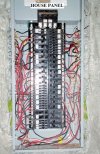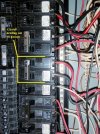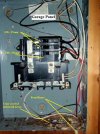Or in the garage you could get a couple Romex connectors, a piece of 12/2 Romex, A metal 4x4 box, a three prong 240 volt/20 amp outlet and cover. Screw the box to the wall next to the garage panel set up the outlet black to flat, white to sideways T and green to U shaped. The other end of the wire goes to garage panel. Put the black wire under the same terminal as the black wire on the 30 amp breaker, the white wire under the same terminal as the red wire on the 30 amp breaker and the bare ground under the same lug as the ground coming from the house panel. You would want to turn off the 30 amp breaker in the house panel that feeds the garage prior to playing around in the garage panel. When your done turn it back on. Oh! I almost forgot. I am an electrical contractor.



